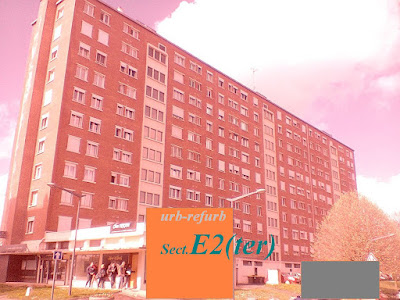high time for a new update on the current situation, being minimal... (do not see me theatre at its best)
- but also plans to move again (been a while with Covid and all that)
re-kindled the traditional 'triangulation drives' but decided to split into two parts
part one - south (second part in various guises, soon, see below)
we thought it good to
rekindle this combination of research & visiting, and due to
circumstances, opted for two separate trajectories – the first
being south along routes we already know and have described
elsewhere, with the exception of Heilbronn, which I never saw before
– so every time there is something different to consider along the
way...

First leg south decided to
do in two days – take some time at stations we usually just whizz
past (fahn fahn fahn auf der autobahn) – taking the A4 direction
Cologne and then the 61 south, which is still closed in parts due to
the damage cause by the raging torrents last year – weather getting
weirder every year – now to hot. Bonn and the requisite grave
visitation, and then along the Rhine – past Coblence then, where
the hills get steeper and rockier towards the Lorelei – which I
have seen from the express train Frankfurt-Cologne many a time, but
never stopped to have a good look – and perhps I waited too long,
since the romantic shores are now festooned with white plastic camper
vans – so much for that romantic vista which Victor Hugo once
illustrated; backdrop to a wagnerian scene of the Rheingold or such –
hard to envisage nowadays – but anyway heading south towards the
'Binger Loch' which always intrigued me – but here too not as
impressed as I might have been a few years back... something lacking
– need of a new choreography perhaps. Short stop at Bingen before
heading further south and into the hills behind the wine-route at
Neustadt... the Palatine forests... here too a sense of loss: many
trees dead or dying, climate change and budworm, no looking good at
all.

We spent the night at the
cloister Esthal, where we had been before, and which each time boasts
less nuns to run the place, now being held together/barely afloat
with some help from the east (polish?) but also in need of a new
concept – not just yoga classes and mindfulness – but who still
wants to work at it? Lovely old orchards and fields going to seed,
crumbling forest and growing graveyard... but still a wonderful place
to stay compared with alternatives in that price-range...
Meandering down the forest
hills into the Rhine valley we had to adjust again to the frenzied
speed-freaks hogging the Autobahn, just in time to get stuck in heavy
traffic (well standstill in fact) at Karlsruhe. Where our old
cafeteria on the river has been refurbished into a kitch-club and no
longer an attractive pit-stop. Slow going, lots of roadworks gumming
up our itinerary – deciding then to head straight for Munich rather
than the Allgäu-route we had considered – backdrop scenery not
really up to scratch anymore anyway... Munich on the other hand went
well – used to be a major drama in various acts to get through –
now a dark passage through new tunnels, but quicker – and so one
might consider t-shirts with 'been to Munich, saw nothing' as novelty
item...
Lucky for us the visit was
at the foothills of the alps and therefore cool and green, as opposed
to the burnt landscape we had left behind – so an idyll that still
exists but for how long?
 |
defaced memorial to death-march victims
|
anti septic Prüm water (holy) dispenser
and jesussandals:
We decided on a zig-zag
return route, avoiding the roadworks we by now knew well, and taking
what turned out to be quite a scenic route west and then north and
then west again, to then head back into the palatine hills and cross
over to Belgium through the Ardennes stopping a Prüm just before the
border... seemingly one of the most important cloisters in it's day,
now sort of forgotten along the way. Founded in 721 by Bertrada the
elder, a great-grandmother of Charlemagne, it had immense power and
territories it it's day and under Pippin III acquired Christ's
sandals from the holy land, still on view today – though scholars
consider them to be merovignian house-shoes (pantouffles) and never
saw the holy grail... anyway, it was an interesting unscheduled find
an I must say I liked a thought over one of the doorways:
“God give all those that
know me
still tenfold more
of what they treat me...”
(1775)
On that note we headed
into the Belgian Haute Fagnes...
and then a major new investigation into territory unknown - east
(more on that later too)
in the meantime a little ditty





















